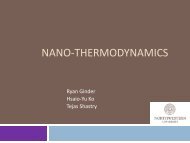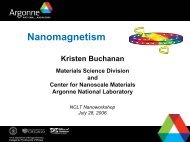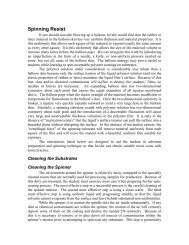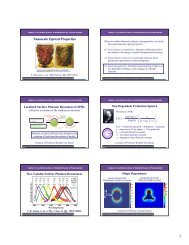A Practical Guide to SPM
A Practical Guide to SPM
A Practical Guide to SPM
You also want an ePaper? Increase the reach of your titles
YUMPU automatically turns print PDFs into web optimized ePapers that Google loves.
9<br />
Tuning forks also improve force sensitivity and greatly facilitate setup,<br />
thus allowing a broader choice of light wavelengths for measurement.<br />
Simultaneous, independent optical and <strong>to</strong>pographic images can then<br />
be taken. It is important that only a very small portion of the sample<br />
be illuminated. This significantly reduces pho<strong>to</strong>bleaching, which helps<br />
clarify the relationship between optical and <strong>to</strong>pographic structure.<br />
Fluorescence is the most commonly used imaging mode; other modes<br />
include UV-visible, IR, and Raman techniques. In addition <strong>to</strong> its remarkable<br />
imaging capabilities, chemical information can be obtained<br />
using near-field spectroscopy at resolutions better than 100nm.<br />
IV. Primary AFM<br />
Imaging Modes<br />
This chapter discusses the four primary AFM modes: TappingMode,<br />
contact, non-contact, and <strong>to</strong>rsional resonance. Many secondary<br />
modes (which will be described in the next chapter) can be derived<br />
from these primary modes.<br />
TappingMode AFM<br />
TappingMode AFM, the most commonly used of all AFM modes, is<br />
a patented technique (Veeco Instruments) that maps <strong>to</strong>pography by<br />
lightly tapping the surface with an oscillating probe tip. The<br />
cantilever's oscillation amplitude changes with sample surface<br />
<strong>to</strong>pography. The <strong>to</strong>pography image is obtained by moni<strong>to</strong>ring these<br />
changes and closing the Z feedback loop <strong>to</strong> minimize them.<br />
TappingMode has become an important AFM technique, as it<br />
overcomes some of the limitations of both contact and non-contact<br />
AFM (also described in this chapter). By eliminating lateral forces that<br />
can damage samples and reduce image resolution, TappingMode<br />
allows routine imaging of samples once considered impossible <strong>to</strong><br />
image with AFMs.<br />
Another major advantage of TappingMode is related <strong>to</strong> limitations that<br />
can arise due <strong>to</strong> the thin layer of liquid that forms on most sample<br />
surfaces in an ambient imaging environment (i.e., in air or some other<br />
gas). The amplitude of the cantilever oscillation in TappingMode<br />
is typically on the order of a few tens of nanometers, which ensures<br />
that the tip does not get stuck in this liquid layer. The amplitude used<br />
in non-contact AFM is much smaller. As a result, the non-contact tip<br />
often gets stuck in the liquid layer unless the scan is performed at a<br />
very slow speed.<br />
In general, TappingMode is much more effective than non-contact<br />
AFM, but especially for imaging larger areas on the sample that may<br />
include greater variation in <strong>to</strong>pography. TappingMode can be<br />
performed in gases and non-corrosive liquids.
















